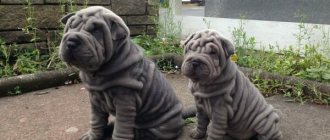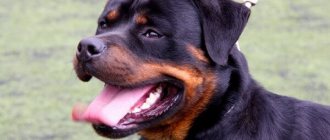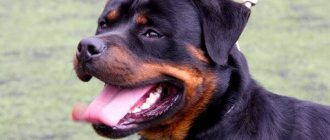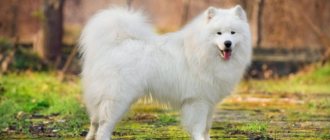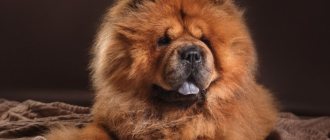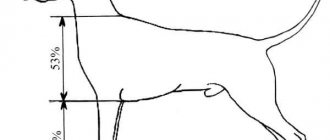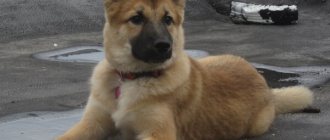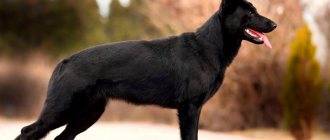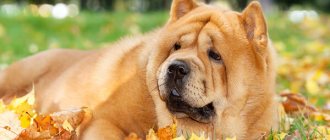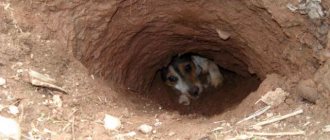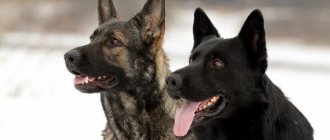Shar Peis were originally short-haired. Other types appeared after US breeders restored the breed in the 1970s after its almost complete destruction in its homeland, China. The communist government that came to power considered pets a legacy of the bourgeois past and mercilessly destroyed the animals.
In the late 1970s, Shar Peis were noted by the sad entry in the Guinness Book of Records: “The rarest dog breed.” The history of the breed could end there. To restore the population, American breeders used similar dog breeds, such as the Chow Chow, and the Shar Pei standard was adopted in 1976, based on new indicators.
What does an adult Shar Pei look like in the photo?
Shar Pei as a dog looks original and unusual . You will not find a similar breed. Such originality is achieved due to numerous folds on the dog’s body, especially on the muzzle.
They also have very short and coarse fur, which looks like velor.
A distinctive feature of this breed is its dark purple or lavender tongue..
The dog has a square body shape, a wide and strong back. Their neck is strong, well set on the shoulders, and their head is large in comparison with the proportions of the rest of the body. The Shar Pei's muzzle is wide, does not taper towards the nose, and the lips are visually full.
The breed's eyes have lowered eyebrows, which gives the impression that they are always frowning. Shar-Peis also have almond-shaped eyes. The animals' ears are small and set high. In appearance they resemble an equilateral triangle.
Shar Pei's tail is thick and curled into a ring..
Interesting Facts
You can tell a lot of interesting things about this breed of dog:
- Scientists believe that Shar Peis, Tibetan Mastiffs and Chow Chows have common ancestors.
- Shar Pei is one of the oldest dog breeds of Chinese origin.
- In tombs dating back to the 3rd century BC. e., the remains of dogs resembling modern Shar-Peis were found.
- In ancient China, Shar-Peis were called "sky-licking dogs" because of their dark tongue. It was believed that with its help animals could scare away evil spirits.
- In 1978, Shar Peis were included in the Guinness Book of Records as the rarest breed in the world.
- The fur of these dogs often causes allergies. Therefore, before purchasing, it is advisable for all family members to interact with the puppy.
Breed standard
Characteristics of the breed standard :
- The dogs' height is 44-51 cm, and their weight is 18-35 years. Life expectancy is about 10-12 years.
- The head is powerful and large, folded. The folds do not cover the Shar-Pei's eyes and do not interfere with them in any way. Smoothly transitions into a dewlap around the neck. The muzzle is wide and without narrowing.
- Scissor bite. The teeth must be complete. The color of the palate, gums and tongue should be dark purple or lavender. Pigment spots on the tongue are allowed, but not completely pink color.
- The nose is black and large, the nostrils are open.
- The eyes are oval or almond shaped and should be dark in color. Their expression is calm; due to their overhanging eyebrows, they may be frowning, but no more; aggression or anger is not allowed.
- The body is square, the neck is strong, the back is wide. The harness should not interfere with the dog's movement.
- The limbs are powerful and confidently placed. Must be without folds. The feet are arched and the toe must be removed.
- The tail is thick and strong, curled into a ring.
Character and temperament
Despite its cute and funny appearance, this breed has a complex character that a beginner will not be able to cope with.
IMPORTANT!
This dog combines all the different character traits: a very high intelligence, good disposition, complete distrust of strangers, as well as excessive arrogance, which the dog can show not only to strangers, but also to family members.
This dog is very attached only to the owner, and treats children quite patiently . Nowadays, Shar Peis only show aggression under strong provocation or when the owner is in danger. The rest of the time they do not get cocky and do not go into open conflict.
Despite the fact that the dog is quite small in size, it can easily fend for itself and its family. The breed is devoid of blind aggression, which makes it an ideal watchdog.
Currently, the Shar Pei has become a companion dog that adapts to the course of a person’s life..
Types and their descriptions (with photographs)
Today there are several types of Shar Pei. But the standard does not distinguish any separate types. Any dog that competes for the right to be called a Shar Pei must obey the description specified in the regulations.
American
There is still debate about whether the American variety of Shar Pei can be recognized on an equal basis with the Chinese.
“Americans”, unlike “Chinese”, are taller. They have long legs, representatives of this species are lean, and the withers are better defined.
Also, the American type is distinguished by a much smaller number of folds on the body. Their muzzle is more tucked up, the upper lip does not hang so low over the lower lip.
“Americans” have a smaller nose, and their eyes are clearly highlighted against the background of their muzzle . Among them, the most common are black or even monochrome individuals in color.
European
This type of breed was developed in Europe. Outwardly, it is very similar to its Chinese counterparts. The main changes occurred in the transformation of character.
The British, through long selection and crossing, obtained a dog that is most similar in character to the people of this country.
Such Shar-Peis are distinguished by even greater calm and almost complete absence of aggression. In this variety, the dog has turned from a watchman into an animal whose guarding skills have been dulled. European Shar Peis are phlegmatic, they prefer leisurely walks and are sedentary.
Over time, the dogs acquired a slightly different appearance than the original.
The structure of the body has changed, so in Europe they look much smaller than their counterparts, and the shape of the body has changed from square to more rounded, which once again emphasizes their inactive lifestyle.
"Bear"
These Shar-Peis are called so because of their incredible resemblance to a bear . They have a long, soft, fluffy, shaggy and flowing coat and are more similar to the Chow Chow than the Chinese variety.
The fact is that Chow Chows also took part in the restoration of the breed. Dogs with long hair appear due to the fact that the genes of a long-haired animal are expressed to a greater extent in an individual.
But this feature is considered a defect. “Bears” are disqualified from participating in exhibitions.
You won’t find such dogs in China, but in America, Russia or Europe they are not uncommon.
Many unscrupulous owners deliberately cut such Shar-Peis, turning them into “purebred” dogs for a while, but such manipulations are often discovered.
NOTE!
At dog shows, judges divide Shar-Pei dogs into varieties, but they almost always give preference to the Chinese Shar-Pei as the most suitable for the standard.
Health
The average lifespan of Shar Peis is 9–11 years and these figures only apply to physically strong, healthy dogs. Quadrupeds with poor genetics live shorter lives and are prone to unexpected pathologies. Diseases inherent in purebred dogs are quite often chronic, that is, they periodically subside and worsen.
NSF or Hereditary Sharpey Fever is an autoinflammatory disease that is inherited. A purely breed pathology. Attacks are expressed in a sharp increase in temperature for no apparent reason. The condition lasts up to 36 hours. Dogs and NHL can live fully for up to 10 years, but there is a risk of developing amyloidosis, which significantly shortens their lifespan.
Important! Renal amyloidosis is considered a rare disease, but it is increasingly being diagnosed in Shar Peis.
Voluminous folds on the muzzle can lead to various ophthalmological disorders. Properly built Shar-Peis are also expected to have eye problems:
- Entropion or entropion - Shar Pei is one of the 10 breeds with the greatest propensity for the disease. Constant irritation of the mucous membrane leads to an inflammatory process. In advanced stages, the dog suffers from corneal ulcerations or blindness.
- Glaucoma – increased intraocular pressure. Accompanied by chronic pressing pain in the head, it can lead to partial or complete loss of vision.
- Third eyelid prolapse – occurs in dogs with large eyes.
Otitis is a fairly common and expected problem for Sharpeis. In a dog with an unimpaired metabolism, the risk of ear inflammation is minimal. In the early stages of food allergies or other ailments that stimulate the mucous membranes, the dog's ears, eyes and skin are affected. Otitis media can be easily determined by examining or massaging your pet's ears; if you hear slurping sounds or the dog jerks its head back (it is in pain), you should not postpone a visit to the veterinarian. Shar Peis are diagnosed with constricted nostrils and tight lip syndrome. In the first case, the dog has difficulty breathing, in the second, it bites its lips. Tight lip syndrome is usually associated with malocclusion, which is also not uncommon in Shar Peis.
Important! Shar Peis have pinned ears and a rather short ear canal; delays in treating otitis media can lead to serious complications!
The Shar Pei's skin is both the pride and the main problem of the breed. The folds create a favorable environment for the proliferation of demodex (a microscopic mite that always lives on a dog’s skin). Slight hypothermia or weakened immunity for another reason can lead to the development of demodicosis. If the dog receives help in time, the disease is completely cured, but the therapy is quite long. Delicate skin texture and folds can trigger the development of:
- Pyoderma of the deep layers of the skin , which is expressed by focal inflammation, the formation of ulcers or self-opening ulcers.
- Seborrhea is the main cause of a strong dog smell and bad-looking fur. Excess sebum clogs the pores of the skin, which leads to disruption of its functioning.
- Eczema and dermatitis of any kind.
The main cause of skin diseases lies in metabolic disorders, which are very dependent on the type of diet. The difficulty is that the breed is characterized by:
- Food allergy is a reaction of the immune system to food. First of all, the dog’s skin suffers (rash, itching, hair loss, eczema formation), secondly, the respiratory tract and eyes due to the hyperactive work of the mucous membranes. The problems do not end with itching and baldness; neglected allergies lead to chronic inflammation of the intestines. The dog develops diarrhea, repeated vomiting, followed by sudden weight loss. An inflamed intestine cannot function fully, that is, the dog does not receive enough carbohydrates, proteins, fats, vitamins and minerals from food.
- Atopic dermatitis caused by non-food allergies is the apogee of all problems. Atopy cannot be cured, and it is impossible to discover its true causes. Dogs with this problem are treated symptomatically and kept on a strict diet.
Important! With atopic dermatitis, the dog constantly itches, loses hair, peels, looks bad and gets sick, and the reason can lie in any object in the house, air pollution or walking area.
Hypothyroidism is a disease of the thyroid gland, or rather, its deficiency. The disease can be the cause of atypical dermatitis and other related, but more serious ailments.
Note! Overweight Shar Peis must be tested for hypothyroidism.
Adult dogs often suffer from elbow and hip dysplasia. The condition is caused by metabolic disorders or its natural (senile) slowdown. Damage to the joint heads leads to lameness and pain when moving. Quite often, in combination with dysplasia, Shar Peis are diagnosed with arthritis.
Mastocytoma or mast cell sarcoma (oncology) is a fairly common diagnosis for Sharpeys. The disease is expressed by tumors of the skin and internal organs. Neoplasms appear due to the degeneration of mast cells (mast cells). The cause of the disease has not been identified and there is no effective treatment. In critical situations, the tumors are excised, but there is no guarantee that the operation will not provoke the growth of one or more mastocytes.
Main types of colors
The standard allows almost any coat color for this breed, except white. Spotting is also unacceptable.
- Black. This color is quite common for Shar-Pei, but representatives of this color are not always purebred. In many cases, the wool has some tint - olive, dark brown, brown or blue-black;
- Deer . This is the most ancient color, because it is no coincidence that Shar Pei is translated as “a dog with sandy hair.” The dog may be golden or sandy in color, but red is not allowed;
- Red . Also a very common color for Shar-Peis. This color can have different variations - from light red to rich red. The most fashionable and spectacular shade is mahogany;
- Red deer . These dogs have light red fur. Small whitish spots on the body are also allowed;
- Cream . The palette varies from milky to caramel. Cream-colored dogs are not white, although they are very similar. Because of this similarity, they are often confused, but cream dogs always have blackness near the nose and on the muzzle;
- Soboliny . In the standard, this color is specified as “zonal gray”. The Shar Pei's coat is of this color, as if with a gray coating, which to some extent extends to the face and limbs;
- Blue. This tone can be considered a weakened black. Shades can also be very diverse. They generally range from smoky gray to dark gray;
- Isabella . The color is considered very rare and complex. It has several tints - creamy pink, bluish or grayish. There must be a black mask on the face;
- Chocolate . This color also has a very large and varied palette - from the color of milk chocolate to the color of bitter and dark;
- Apricot . He is considered a weakened cervid. The dog has a golden-reddish coat, very warm and sunny;
- Lilac . Like Isabella, this is a rare color for the Shar Pei. It is very complex, the palette varies from chocolate with a certain pink undertone to warm pinkish blue or silvery pink with haze. On the face there is not a black, but a bluish mask.
Tongue color
In a Shar-Pei of the main color, the tongue can be exclusively blue-black; for a dog of dilute color, a lighter, lavender shade is acceptable. The color of the tongue is already visible in small puppies, although many of them are born with a lack of pigmentation. An adult dog's tongue should be spotless and one solid color.
Important! A pink tongue in a dog of this breed is considered a disqualifying fault.
Shar Pei is a dog whose character and appearance have been developed over centuries through the painstaking work of breeders. This dog has a number of specific characteristics that distinguish it from other breeds and make it unlike any other dog. All the features inherent in the Shar Pei were reflected in the standard of this amazing breed.
Smooth-haired and long-haired
Shar-Peis are divided into two types based on their coat type.:
- Horse . The fur of this animal is more like bristles - short and hard, without undercoat. Its length barely reaches 1 cm in most cases;
- Brush . These dogs have elastic spines. It is much softer than that of Horses, it grows thickly, but there is also no undercoat. Brushes' fur is 1-2.5 cm long.
Since Shar-Peis do not have an undercoat, grooming and trimming of this breed is not allowed, because it can be harmful to the animal's skin.
Nutrition
Shar Peis are very sensitive to the quality of food. It is very difficult to provide many of them with a balanced natural diet due to food intolerance, weak stomach and allergies. Breeders recommend individually choosing a good ready-made super-premium or holistic food for your dog.
If you decide to give preference to natural nutrition, you need to approach menu planning wisely, and you may need the help of a specialist. An adult Shar Pei should eat about 1 kg of food per day or 3.5% of its weight. Half of the entire diet should consist of lean meats, offal and fish. Eggs can be given 1-2 times a week. The other half is allocated to cereals (brown rice, buckwheat). The daily menu should be diversified and supplemented with vegetables, herbs and dairy products.
What do boys and girls look like and how are they different?
Externally, Shar Pei males and females are not much different.
This breed does not even have any special differences in height and weight in male and female genders. And if you have not dealt with Shar Pei representatives, then you are unlikely to be able to determine at first glance who is standing in front of you - a boy or a girl? However, there are still differences.
Most often, females are more elongated than males, that is, their body shape is more rectangular than square..
Despite the fact that there is no division by height and weight, females are often still slightly smaller than males. This feature is difficult to catch with an inexperienced eye.
Also, if the dog has already given birth, then the bitch can be easily identified by her belly: after giving birth and feeding, the previous fit of the bottom becomes more blurred, and without special training it can even sag.
Males look leaner and more muscular than females . They also differ in character to some extent. Males are possessive, more independent and disobedient. Bitches are flexible, they are much softer and kinder than males.
Thus, there are still differences between a Shar Pei boy and a girl, although not noticeable at first glance.
Appearance of puppies
Appearance of puppies at different ages:
- 1 month . At this age it is still too early to adopt a puppy into the family. He is still attached to his mother and other brothers, moreover, he still needs his mother's milk. A dog at this age is covered with many folds, which is why it looks touching. The legs are still short, as is the tail, which is too early to curl behind the back.
- 2 months . This is the age when you can already take a Shar Pei to your home. It's still covered in funny and cute folds, but they don't hang off it as much. The puppy has grown noticeably compared to last month. The legs have lengthened, and the tail is already curled.
- 3 months . This is the time to start training. The puppy has grown noticeably, the folds have become much smaller, only the eyebrows hang over the eyes, and the upper lip remains larger than the lower one.
- 4 months . A period of active growth. The puppy begins to socialize, at this time you need to start introducing him to other dogs. The folds still remain on the dog's body, but they are almost invisible. The proportions of an adult dog begin to be guessed in the pet.
- 5 months . The folds on the body are smoothed out and remain only on the face and withers. The dog becomes even larger, its legs lengthen. Puberty will begin soon, but in the meantime, your pet may begin to fight for the right to be the main one in your relationship.
- 6 months . The period of development of the puppy's personality continues. If the last stage was completed successfully, then now the dog will become incredibly loyal to you. The Shar Pei is becoming more and more like an adult animal. At this time, male dogs may begin puberty.
- 7-9 months . The dog's growth and weight gradually slows down. By 9 months, the Shar Pei has already fully acquired the appearance of an adult. By 8 months, female dogs may go into heat.
- 10-12 months . The final completion of growing up. By the age of one year the dog reaches its harmonious size. The psyche is also completing its formation. From this stage it will be difficult or almost impossible to retrain or re-educate the Shar Pei.
Care
The short coat makes the Shar Pei comfortable and easy to care for. Brush the dog once a week with a special mitten or brush for short-haired breeds. This “miracle in a fold” is not bathed often, several times a year. To avoid possible skin irritation and get rid of excess moisture in the folds, use a special powder for dogs.
Your dog needs to be taught all hygiene procedures from childhood. It is almost impossible to cope with an adult Shar Pei that does not consider it necessary to brush its ears or teeth.
You need to look into your ears a couple of times a week. If sulfur has accumulated, it is carefully removed with a cotton swab soaked in peroxide or a special lotion. Secretions may accumulate in the corners of the eyes. It must be carefully removed with a cotton pad or soft cloth. Many dogs' nails can be successfully ground down on their own, but sometimes owner intervention is needed. Overgrown claws are cut off with special nail clippers.
A Shar Pei's teeth usually do not require care when they are young, but since modern dogs more often live into adulthood, when dental problems become relevant, it will be better if the dog is accustomed to manipulating teeth from puppyhood. When changing teeth, you can massage your gums, and then from time to time brush your teeth with a special paste.
How to choose?
Choosing a puppy is always a responsible task, but when it comes to a Shar Pei, everything is very serious.
CAREFULLY!
If you have never encountered this breed before, it is better to take a specialist with you or carefully consult with him, because the range of risks when choosing a Shar Pei is large.
It is best to always buy a puppy with a pedigree, even if you do not plan for its show career. The fact is that when purchasing a puppy from your own hands, you run the risk of getting a “pig in a poke” with health and mental problems that will appear later, or even a mixed breed.
Check the availability of all documents and veterinary certificates . Also examine the puppy itself - it should be healthy, active, with clean mucous membranes and hair.
Be sure to look at how the puppies eat. The breed is prone to idiopathic enlargement of the esophagus, which is characterized by difficulty swallowing and excessive salivation. An examination by your veterinarian should be mandatory.
Price
Shar Pei is a rare and therefore expensive breed of dog. There is an excellent nursery in Moscow where its representatives are raised for sale. If you dream of becoming the owner of such a wonderful dog, we recommend going there for him.
The price of a sharpei with a pedigree is from 13 to 35 thousand rubles. It depends on the color, size, documentation, the presence of titles and prizes from the puppy’s parents and other important parameters.
Private breeders sell Shar Pei cheaper, from 10 thousand rubles. But when cooperating with them, do not count on purchasing an absolutely healthy and high-quality puppy.
